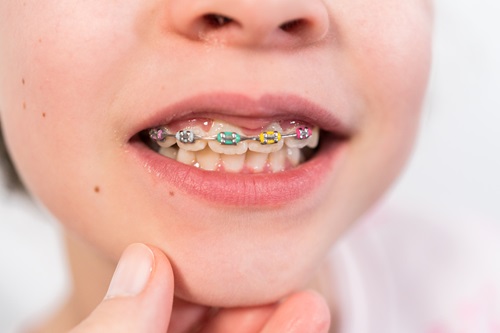When Is the Right Time to Consider Dental Braces for My Child?

As a parent, we understand how important it is to put your child’s health as a priority. However, we also acknowledge that making decisions about your child’s health can sometimes feel overwhelming, especially when it comes to their dental health.
Speaking of dental health, one of the many questions parents face is when to consider dental braces for their child. Let’s learn more about what dental braces are used for, the best age for braces, and the telltale signs that your child may need them.
Maybe this blog can help make this decision a bit easier.
What Are Dental Braces Used For?
Dental braces are the most common orthodontic treatment in Australia. It was even said that there are currently over 300,000 Australians who have braces or aligners, and 75% of that population is children. Because of that, it’s clear that dental braces are helpful in correcting a variety of dental issues.
Here’s a brief overview of what braces can help with:
Misaligned Teeth
Braces are commonly used to straighten teeth that are crooked or misaligned. Properly aligned teeth not only improve appearance but also make it easier for children to maintain their oral hygiene.
Bite Issues
Bite issues can happen because of different reasons. Genetics, injuries, and oral habits are just some of the causes behind them. Dental braces can correct bite issues that can affect a child’s chewing, speech, and overall oral health. Some examples of bite issues include overbite, underbite, crossbite, and open bite.
Spacing Problems
Braces easily bridge the gaps between teeth and prevent overcrowding. Properly spaced teeth reduce the risk of plaque build-up and tooth decay.
Common Signs That Your Child May Need Braces
While regular dental check-ups are essential, keep an eye out for these indicators:
- Early or late loss of baby teeth (the teeth that usually fall out before the permanent teeth grow)
- Difficulty chewing or biting
- Mouth breathing
- Thumb sucking or other harmful oral habits
- Crooked, crowded, or spaced teeth
- Jaws that shift or make noise when chewing
- A bite that doesn’t fit together correctly
If you notice any of these signs, it might be best to schedule an orthodontic consultation with your dentist.
What Age Is Best for Dental Braces?
The ideal age for your child to get dental braces may vary depending on different factors such as their dental situation, but there are general guidelines to help determine the best age for their orthodontic treatment.
Early Evaluation
The Australian Society of Orthodontists recommends that children have an orthodontic evaluation by the age of 7. This early check-up allows the orthodontist to identify any potential issues that may benefit from early intervention.
Ages 7 to 14
Most children get braces between the ages of 7 and 14. During this stage, most of their permanent teeth have erupted already, but the jaw is still growing. This makes it an ideal time for orthodontic treatments, so their teeth are appropriately aligned.
Individual Needs
The most important one to remember is that every child is different, and the timing for braces will depend on their specific dental needs. Some children may require early intervention, while others may benefit from waiting until their teenage years.
Choosing the Right Orthodontic Treatment for Your Child
Traditional Metal Braces
Metal braces are the most common and oldest type of teeth-aligning appliances that are made of high-grade stainless steel. They also have brackets and rubbers to help move the teeth to where they should be. These are highly effective and can be customised with coloured bands for a fun look.
Ceramic Braces
Ceramic braces are less visible than metal braces, making them a popular choice for children concerned about appearance. They function similarly to metal braces but are made of clear or tooth-coloured materials.
Lingual Braces
Lingual braces are attached to the back of the teeth, making them invisible from the front. They can be more challenging to clean and adjust but offer a discreet option for kids.
Clear Aligners
Clear aligners, such as Invisalign, are a series of custom-made, removable trays that gradually shift teeth into place. They are a great option for kids who prefer not to have fixed braces and want the flexibility to remove them for eating and brushing.
Benefits of Early Orthodontic Treatment
Considering braces for your child at the right time can provide several benefits:
- Improved Oral Health: Early orthodontic treatment can prevent more serious dental problems in the future. Properly aligned teeth are easier to clean and maintain and lessen the risk of getting cavities and gum disease.
- Enhanced Self-Esteem: A straight, healthy smile can make your child less shy when they socialise or communicate with other people during their formative years.
- Easier Treatment: Early treatment can often lead to shorter and less complex treatment plans, making the process easier for your child.
Creating a Beautiful and Healthy Smile
So, can kids wear dental braces? Absolutely! And if you’re deciding when to get dental braces for your child, the best option to do is to have a consultation with their dentist. Early evaluation and treatment can provide numerous benefits, leading to a healthier, more aligned smile.
If you need partners in your oral healthcare, don’t hesitate to contact our dental experts at Blue Gum Dental today for exceptional care and advice. Our team of experienced orthodontists is here to provide the best care for your child’s unique needs. Schedule a consultation today to learn more about how we can help your child achieve a beautiful, healthy smile.
